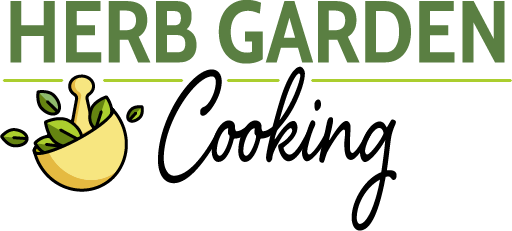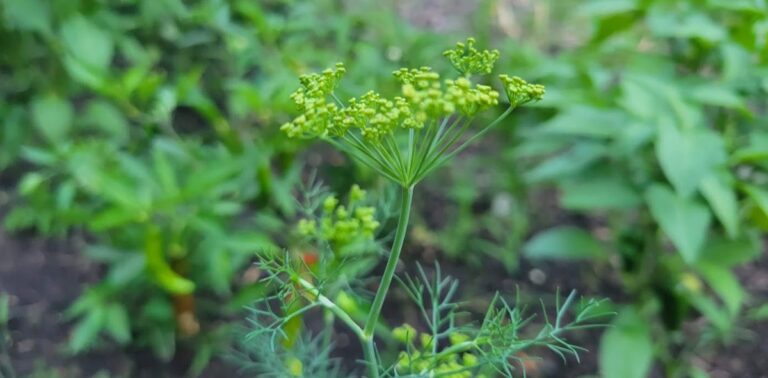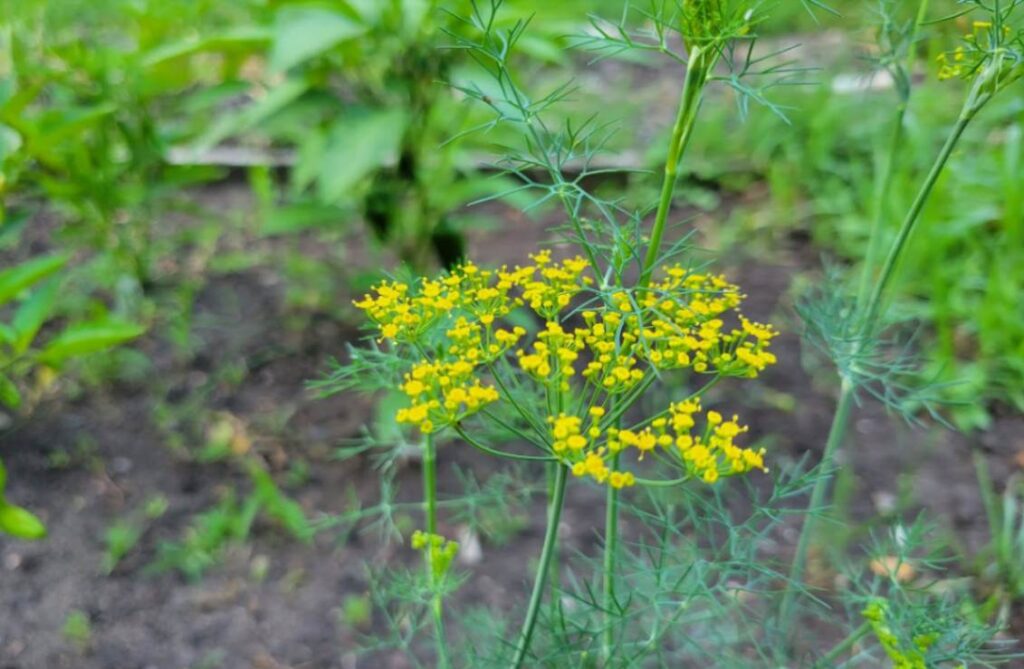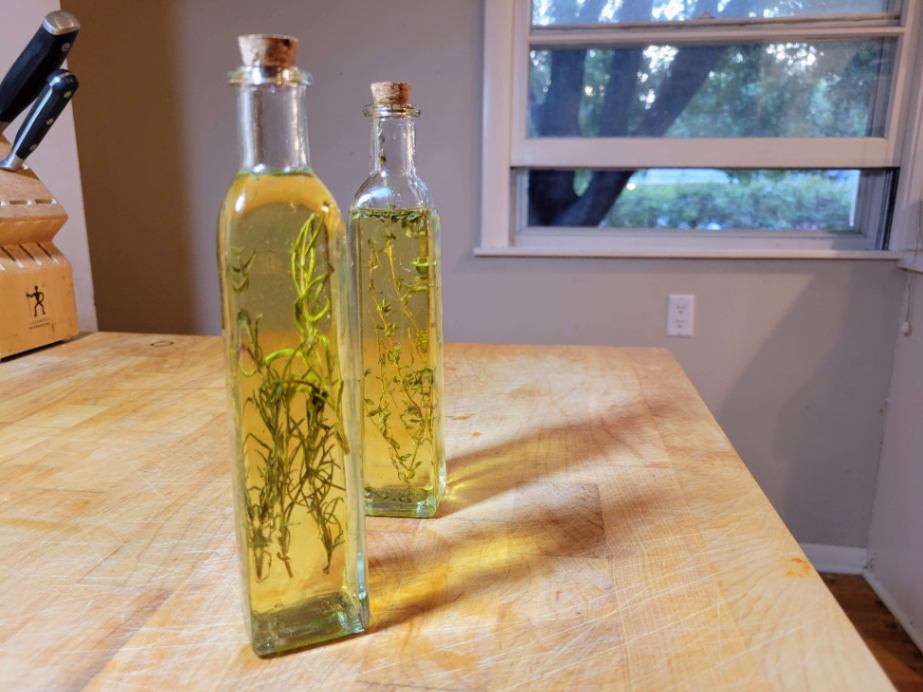This post may contain affiliate links which means I may receive a commission for purchases made through links. I only recommend products that I have personally used. As an Amazon Associate I earn from qualifying purchases. Learn more on my Private Policy page.
Dill is a delicate herb from the Apiaceae family with feathery leaves and yellow flowers. Native to the Mediterranean and Southern Russia regions, it is renowned for its distinct aroma and flavor. Dill is commonly grown in home gardens due to its ease of cultivation and versatile culinary uses.
Related Articles:
Table of Contents
Growing Dill: Cultivation and Care Guide
Dill Prefers Full Sun and Well-Drained Soil
Dill requires at least six to eight hours of direct sunlight daily to grow optimally. Dill has moderate watering requirements and prefers moist, well-drained, slightly acidic to neutral soil with a pH level between 5.5 and 6.5.
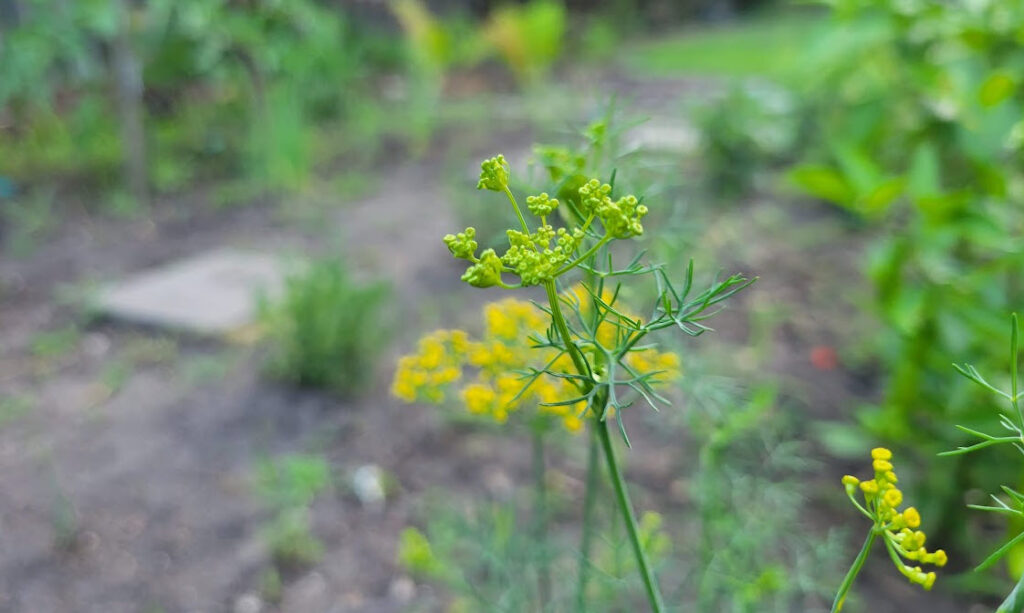
Growing Dill: Seeds or Transplants?
You have two options to grow dill: starting from seeds or using transplants. Starting from seeds allows you to control the entire growth process while using transplants provides a head start by skipping the germination stage.
If you choose to start from seeds, you can either start them indoors or sow them directly into the ground after the last frost date in your area. Ensure that the soil is moist but not waterlogged during germination.
How to Grow Herbs from Seeds Indoors
Cultivating herbs from seeds can be rewarding and provide an abundance of fresh, aromatic herbs for the home cook. Read More…
Pruning for Bushier Dill Plants
To encourage bushier growth in your dill plants, pruning is essential. Once your dill plants reach a height of around 6 to 8 inches (15-20 cm), pinch off the top portion of each stem just above a set of leaves. This will stimulate branching and result in fuller foliage. Regular pruning throughout the growing season will help maintain compact plants and prevent them from becoming leggy.
Companion Planting with Dill
Dill thrives when planted alongside vegetables such as cucumbers, corn, lettuce, asparagus, and brassica family members such as cabbage, broccoli, and kale. This is because dill has the unique capability to attract beneficial insects to the garden, which in turn helps to deter the common pests that often target these plants.
Dill also makes for a compatible companion with herbs like basil and chervil. However, it’s important to note that dill can inhibit the growth of carrots and fennel due to its allelopathic effects.
For more in-depth information on what grows well with dill and what doesn’t, check out my comprehensive article on dill companion planting…
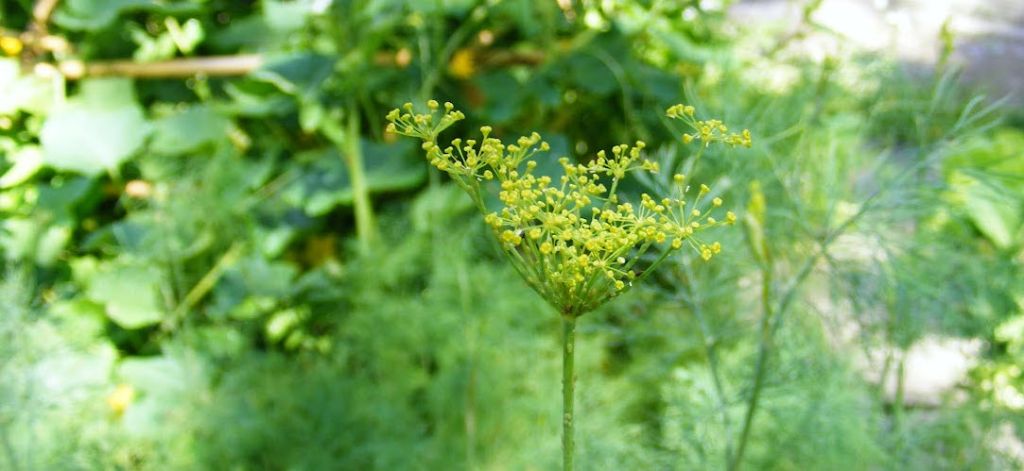
Dill Companion Planting Guide: Best Plants to Pair
Discover the best plants to pair with dill for successful companion planting. Learn which veggies and herbs to not plan with dill. Read More…
Harvesting and Preserving Dill
Harvesting Dill for Continuous Growth
Dill harvesting can begin once the plant has reached a height of about 12 inches. Cut the leafy stems near the base of the plant using sharp scissors or pruning shears. Harvesting in the morning when the essential oils are at their peak concentration is best. Harvest only a portion of the plant at a time to allow for continued growth and foliage production.
Harvesting Dill: Proven Techniques to Preserve Freshness
Learn the best techniques for harvesting dill and maximizing your yield. Preserve and store your dill for later use. Read More…
Storing Fresh Dill
Fresh dill can be stored in various ways to maintain its flavor and quality. One popular method is placing the stems in a glass of water, similar to storing fresh flowers. Covering the top loosely with a plastic bag helps retain moisture. Alternatively, you can wrap fresh dill in damp paper towels and store it in an airtight container or resealable plastic bag in the refrigerator. This will help keep it crisp and prevent wilting.
Preservation Methods for Dill
If you have an abundance of dill and want to preserve it for future use, there are several methods you can try:
- Drying: Hang small bunches of dill upside down in a well-ventilated area away from direct sunlight until completely dry. Once dried, remove the leaves from the stems and store them in an airtight container.
- Freezing: Chop fresh dill into desired portions and either pack them tightly into freezer bags or place them into ice cube trays filled with water or oil. Once frozen, transfer the cubes into freezer bags for easy access when cooking.
- Herb-infused oils and vinegar: Combine fresh dill with herbs like coriander or caraway to infuse oils or vinegar. These can be used in dressings, marinades, or as a flavorful garnish for various dishes.
Preserving dill allows you to enjoy its distinct flavor throughout the year, even when it’s not in season. Experimenting with different preservation methods can also help you discover new ways to incorporate dill into your cooking.
Can You Freeze Dill? Discover 3 Ways
Discover the ideal way to preserve dill. Learn how to freeze dill and explore the benefits of freezing versus drying. Find out which freezing method suits your culinary needs. Read More…
7 Best Culinary Herbs for Infused Oils (& How to Infuse Them)
Rosemary is one of the best herbs to use for oil infusion. Herb-infused oils are widely employed in culinary applications where oil is a suitable cooking ingredient. Read More…
Culinary Uses of Dill
Dill is a versatile ingredient in the culinary world. Let’s explore some of the ways dill can be used to enhance the flavors of various dishes.
Exploring Dill as a Commonly Used Seasoning
Dill is widely used as a seasoning in many cuisines around the world. Its unique flavor profile, which can be described as fresh, tangy, and slightly sweet, adds depth and complexity to dishes. Whether it’s sprinkled on salads, mixed into dressings or sauces, or added to soups and stews, dill brings a refreshing burst of flavor that complements a wide range of ingredients.
- Sprinkle dill over roasted vegetables like carrots or potatoes for an extra layer of flavor.
- Mix dill into mayonnaise or yogurt to create a delicious dip or spread.
- Use dill as a seasoning for grilled chicken or roasted meats to add an aromatic touch.
Adds a Fresh Taste to Fish Dishes
One of the most popular culinary uses of dill is in fish dishes. The herb pairs exceptionally well with seafood and helps bring out fish’s natural flavors. It adds a fresh and vibrant taste that cuts through the richness of fatty fish varieties like salmon or trout.
- Craft a flavorful dill sauce for fish by combining chopped fresh dill with sour cream or Greek yogurt, lemon juice, garlic, salt, and pepper. This sauce can be served alongside grilled or baked fish for an exquisite combination.
- Sprinkle chopped dill over pan-seared fish fillets just before serving to add brightness and visual appeal.
- Infuse olive oil with fresh dill sprigs and use it as a marinade for fish before grilling or baking.

Enhances the Flavor of Roasted Vegetables
Roasted vegetables can be taken to the next level when infused with the distinct taste of dill. The herb’s delicate and aromatic flavor complements the earthiness of roasted vegetables, creating a harmonious blend of tastes.
- Toss chopped dill with olive oil, salt, and pepper before roasting vegetables like zucchini, eggplant, or bell peppers for a burst of freshness.
- Mix roasted potatoes with melted butter and finely chopped dill for a flavorful side dish that pairs well with grilled meats or fish.
- Add dill to roasted cauliflower or broccoli for an unexpected twist on these classic vegetables.
Popular Ingredient in Scandinavian Cuisine
Dill holds a special place in Scandinavian cuisine. It is widely used in traditional dishes such as gravlax (cured salmon), pickled herring, and creamy potato salads. The herb’s bright flavor complements the region’s seafood-focused cuisine perfectly.
- Combine fresh dill with salt, sugar, and crushed peppercorns to create a curing mixture for homemade gravlax. This traditional Scandinavian delicacy is made by marinating salmon fillets with the mixture and letting them cure in the refrigerator for a few days.
- Use dill as a garnish for open-faced sandwiches called smørrebrød, which are commonly topped with fish or seafood.
- Incorporate chopped dill into creamy potato salads along with mayonnaise or sour cream for a refreshing side dish.
Dill’s versatility as an herb makes it an excellent addition to various culinary creations. Its unique flavor profile adds freshness and complexity to dishes ranging from fish and vegetable preparations to sauces and dressings. By harnessing the power of dill in your cooking, you can elevate your meals to new heights of deliciousness.

Nutrition and Health Benefits of Dill
Dill is a powerhouse herb rich in essential vitamins and minerals, making it a valuable addition to your diet for maintaining good health and providing additional health benefits.
Vitamins in Dill
Dill is a nutrient-packed herb that offers various vitamins and minerals essential for maintaining good health.
- Vitamin C: Boosts the immune system and promotes healthy skin.
- Vitamin A: Supports eye health and contributes to overall vision.
- Vitamin K: Plays a role in blood clotting.
- Folate: Crucial for cell growth and development.
Minerals Present in Dill
Dill is an excellent source of several minerals, which are also abundant in this herb.
- Calcium: Necessary for strong bones and teeth.
- Iron: Essential for oxygen transport throughout the body.
- Potassium: Helps regulate blood pressure levels.
Dill’s Potential Antioxidant Properties
Dill contains various antioxidants like flavonoids and polyphenols that may have potential health benefits and help protect cells from damage caused by harmful molecules called free radicals.
Research suggests that the antioxidants present in dill may reduce the risk of chronic diseases[1]. These compounds help neutralize free radicals, preventing them from causing oxidative stress within the body.

Dill as a Digestive Aid
Dill has long been recognized for its digestive properties as it contains natural compounds that can aid digestion and alleviate common digestive issues.
One notable compound found in dill is carvone, which possesses antispasmodic properties that may help relieve stomach cramps or spasms[2].
Moreover, dill has been used traditionally as a remedy for bad breath or halitosis due to its antimicrobial properties. Chewing on fresh dill leaves or consuming dishes seasoned with dill can help freshen your breath and combat oral bacteria.
Historical and Cultural Significance of Dill
Cultural Meaning of Dill
- Wealth and Prosperity: In Middle Eastern and Mediterranean cultures, dill has been seen as a symbol of wealth and prosperity. This may be due to its historical use in culinary dishes that were considered luxurious.
- Protection: Dill has also been believed to ward off evil spirits in several cultures. In medieval Europe, Norse, and Scandinavian cultures, it was thought that hanging dill over the door or placing it in various parts of the home such as near baby cradles could ward off witchcraft, evil spirits, and negative energies.
- Love and Romance: In European folklore, dill was associated with love and believed to bring romantic dreams. It was believed that placing dill leaves under one’s pillow could lead to romantic dreams or help one find love. In some cultures, Dill has also been used as an ingredient in love charms and spells.
Historical Significance of Dill
- Ancient Egyptians: Dill was likely used for culinary and possibly medicinal purposes in ancient Egypt, as evidenced by dill seeds having been found in the tomb of Pharaoh Amenhotep II (which dates to 1427 BC).
- Ancient Greece and Rome: Dill is mentioned in ancient Greek and Roman texts. It was used in wreaths and garlands during weddings as protection. It was valued for its flavor and was believed to have healing properties by ancient Greeks and Romans.

Frequently Asked Questions (FAQs)
Can I grow dill indoors?
You can grow dill indoors if you provide it with sufficient light and well-draining soil. Place it near a south-facing window or use artificial grow lights to ensure proper growth.
How often should I water my dill plants?
Dill prefers slightly moist soil but does not tolerate overwatering. Water your plants when the top inch of soil feels dry to the touch.
Can I freeze fresh dill?
Freezing is an excellent method for preserving fresh dill. Wash and pat dry the leaves before placing them in an airtight container or freezer bag. Freezing dill preserves more of its flavor than drying it, although drying extends its shelf-life.
What are some common culinary uses for dill?
Dill is commonly used in pickling cucumbers, flavoring fish dishes, adding freshness to salads or dressings, enhancing sauces or dips like tzatziki, and garnishing soups or stews.
Does dried dill have the same flavor as fresh dill?
While dried dill retains some of its flavor, it is generally less potent than fresh dill. Adjust the amount accordingly when substituting dried dill for fresh in recipes.
Sources
- Haidari, F., Zakerkish, M., Borazjani, F. et al. The effects of Anethum graveolens (dill) powder supplementation on clinical and metabolic status in patients with type 2 diabetes. Trials 21, 483 (2020). https://doi.org/10.1186/s13063-020-04401-3
- Souza FV, da Rocha MB, de Souza DP, Marçal RM. (-)-Carvone: antispasmodic effect and mode of action. Fitoterapia. 2013 Mar;85:20-4. doi: 10.1016/j.fitote.2012.10.012. Epub 2012 Oct 24. PMID: 23103297
Last Updated on 25 October 2023 by Bob Lee
